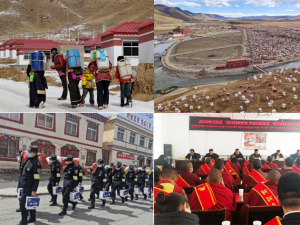Theme 3
Economics Rights Violations by China
The Chinese Communist Party’s claim of unprecedented economic success in Tibet demonstrates its desperate attempt to legitimize its illegal and oppressive rule over Tibet.
In 1986, The United Nations General Assembly passed the Declaration on the Right to Development and is defined as a “comprehensive economic, social, cultural and political process, which aims at the constant improvement of the well-being of the entire population and of all individuals, on the basis of their active, free and meaningful participation in development and in the fair distribution of benefits resulting therefrom.”
On 21 May 2021, The Chinese Communist Party in their latest White Paper titled “Tibet Since 1951: Liberation, Development and Prosperity” reasserted China’s claim of guiding Tibet towards economic salvation and fanfaronade over the achievement of rapid economic growth and infrastructure development in Tibet. On the contrary, the CCP’s claims remain visibly inaccurate and false in the face of their colonialist endeavors in Tibet. Questions arise from the need to look into who the development in Tibet is for, as the record consistently shows that the development of Tibet is a means to an end to fulfill CCP’s interests. In contrast, the developmental model that Beijing has implemented in Tibet has regularly marginalized and neglected the fulfillment of the needs of the Tibetan people, raising serious implications over the social, economic, and cultural rights of the Tibetan people and its ecology.
According to the Central Tibetan Administration’s response to aforementioned China’s White Paper, “The establishment and operation of an alien political economy in Tibet has further deepened the overdependence and extreme disempowerment in terms of not having a form of government run by and for the Tibetan people to promote and protect their interests.”
A long list of roads, railways, and airports is omnipresent throughout its white paper on Tibet, as CCP never fails to laud themselves over the infrastructure boom that they have bestowed upon Tibetan people. Within the first two decades after the occupation, massive road building and bridges in Tibet were a main priority for the occupying forces of the CCP to consolidate and facilitate the movement of its massive armies and weapons into Tibet. Noticeably, the majority of the airports and railways are strategically placed close to the Indo-Tibet border, or either near their military and administrative quarters.
The infrastructure development in Tibet serves the CCP’s colonial desire in their pursuit towards exploitation and extraction of Tibet’s rich resources and environment. Railways are selectively built along with the high mineral concentrated areas such as Gyama and Shetongmon where copper and gold are found in abundance, Chromium, and Iron in Norbusa, lithium in Drag ye Tsaka, and the list of exploited areas goes on. China’s extraction of Tibetan minerals is reportedly worth around $128 billion. The production of mobile phones and laptops which constitute a significant part of China’s exports is dependent on lithium, and 90% of China’s Lithium reserves are extracted from the Tibetan Plateau. Furthermore, the exploitation of Tibet’s rich natural resources continues in logging of timber through massive deforestation, damming of rivers, poaching of wild animals resulting in severe environmental destruction.
Instead of empowering the local economy and its people, the subsidy-induced development of Tibet has made the Tibet economy crippled, extremely disempowered, overdependent, and more susceptible to domination by CCP.
For mass surveillance and solidification of its ironclad control over Tibet, for a long time, China has pursued a campaign to end the Tibetan nomadic way of life through mass resettlement programs and criminalization of pastoralism, impoverishing the local Tibetans all under the euphemism of “poverty alleviation” and “development”. Since 2012, ecological and poverty alleviation programs such as the ‘pairing assistance’ program in Tibet have led to the nationwide deployment of party members and local cadres. Within “TAR”, a total of 22,000 party members and government cadres were posted in 5,467 villages including 1700 religious’ institutions in 2016.
The report of the Special Rapporteur on the right to food in December 2010 elucidated on the destruction of Tibetan’s livelihood sources of nomadic and farming communities and deprivation of their economic independence by stating that China’s resettlement policy has led to “loss of land, limited ability to keep livestock, relocation in areas unsuitable to agriculture, and generally a disruption of traditional patterns of livelihood.”
Since the advent of CCP’s oppressive rule in Tibet, the development policies and practices adopted in Tibet in the last seven decades have consistently undermined and blatantly violated the economic rights enshrined in the International Covenant on Economic, Social, and Cultural rights.
The UN Committee on Economic, Social, and Cultural Rights was established in 1985 and is tasked with the responsibility to monitor the implementation of the International Covenant on Economic, Social, and Cultural Rights by its state parties.
On 27 March 2001, China ratified the ICESCR. The third periodic report on China by the UN Committee on Economic, Social and Cultural Rights questioned China over its lack of implementation of the International Covenant on Economic, Social and Cultural Rights. Concerning the protection of the economic rights of the Tibetan people, the report outlined serious violation and non-compliance of Articles 6 and 7 of the International Covenant of Social, Economic, and Cultural Rights.
Beijing’s enforcement of the militarized labor camps across the so-called “Tibet Autonomous Region” is in direct violation of the Right to Work and Right to a Fair Wage and Safe Working Conditions of the Tibetan People. In September 2020, China’s implementation of the militarized vocational training system in Tibet came to the surface through a Jamestown Foundation report authored by Adrian Zenz, an independent researcher specializing in Tibet and East Turkestan. Under the guise of alleviating poverty, China introduced new policies coercing thousands of Tibetans in the region into mass labor through a militarised system in the so-called Tibet Autonomous Region (TAR). According to the report, the training initially began with 543,000 laborers of which 49,000 were transferred to other parts of TAR after the completion of 7 months of training. A total of 3109 laborers were transferred to other parts of China. It is said that by the end of 2020, the labor scheme must cover the whole of TAR. Tibetans in these coercive labor training have to forcibly undergo indoctrination, intensive surveillance, military-style enforcement, and harsh treatments. The study also reported that transferred laborers were assigned to low-paid jobs in road construction, mining, cooking, and driving, etc.
The Committee also reported that China is in breach of two relevant conventions, – Forced Labor Convention and Abolition of Forced Labor Convention, prompting the Committee to urge China to stop the inflictions of the brutal mental and physical torture and abuses of the Tibetans and other “ethnic minorities groups through the vocational training programs and forced labor. The report also raised concern over the lack of free choice of jobs and access to employment in China. Moreover, the committee stressed the need to take steps towards the prohibition of discrimination by public and private employers against persons belonging to “ethnic minorities”. Moreover, the report also raised concern over the lack of free choice of jobs and access to employment in China
Beijing’s violations of economic rights of the Tibetan people and Uighur and other “minority” populations is both systemic and structural. Tibetans, Uighur, and other “minority” peoples are systematically and structurally marginalized and discriminated against in terms of their employment in both public and private sectors. The CCP has deliberately neglected the core obligation of a state in Article 6 of the Covenant to avoid measures that discriminate against marginalized groups and have significantly undermined the right to access to employment. Tibetans face disadvantages and exclusion in the working environment, due to the dominance of the culture and the language of the Chinese majority, and it is becoming increasingly prominent and mandatory. The encouragement and subsidization provided for the Chinese Workers and recent graduates to migrants and work in Tibet introduced through programs like ‘Western Development Strategy’ only accentuate Beijing’s malicious characteristics of its development model.
In 2014, the UN Committee on Economic, Social, and Cultural Rights revealed that there is a higher rate of unemployment among Tibetans, Uighurs, and Inner Mongolians owing to the high influx of Chinese migration into these regions. Tibetans and other “minority” populations face further marginalization in terms of employment, which regularly discriminates and puts them in a disadvantaged position. On May 25 2020, an announcement for “Public Recruitment of Police Auxiliary Personnel” was issued by eight departments in Lithang County revealing participation or support for “ethnic separatist activities” as a disqualifying condition. Such practices are discriminatory towards Tibetans as according to the Chinese government, “separatist activities” also include expressions and celebration by the Tibetan of their unique culture and religion.
QUESTIONS AND ISSUES TO BE CONSIDERED
- What are the flaws in China’s model of economic development of Tibet, East Turkestan, and Southern Mongolia?
- How does the development of Tibet serve the CCP’s interests?
- How has China’s economic development model violated the economic rights of the Tibetans, Uighurs, and Southern Mongolians and further marginalised them?
- What are the repercussions of China’s attempts to promote Tibet as an ideal developmental model on International Human Rights law?
- How has China employed the use of euphemisms such as “poverty alleviation” and “development” to cause damage and destruction to Tibetan nomads?


